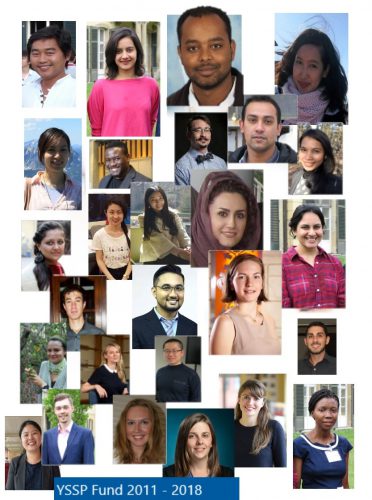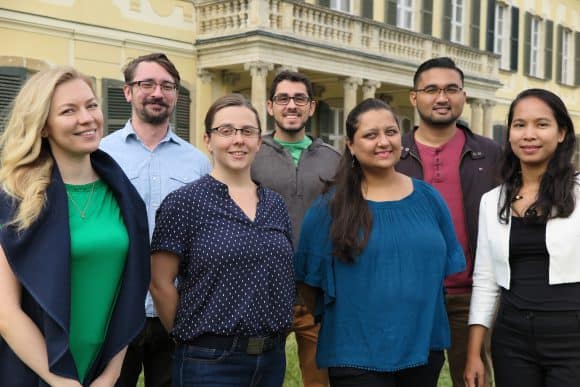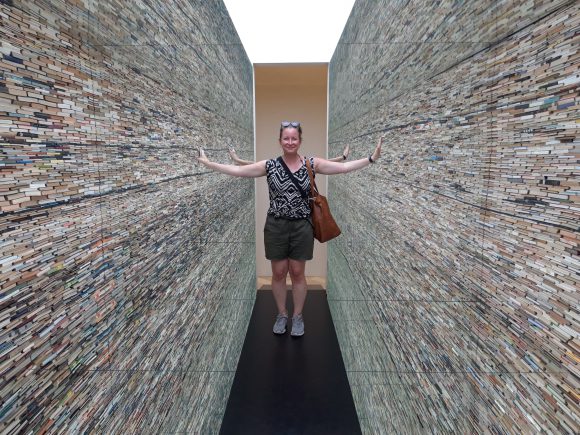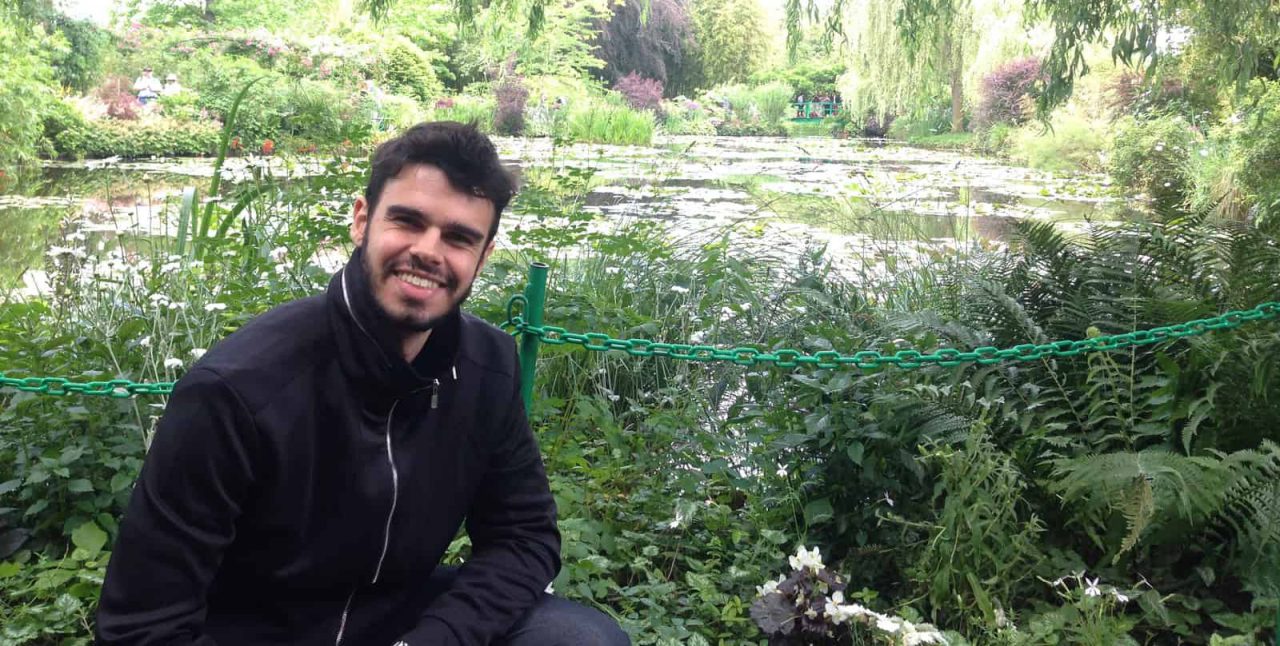Jan 21, 2019 | Alumni, IIASA Network, Young Scientists
By Marzena Anna Adamczuk, Development Officer, Office of Sponsored Research, IIASA

YSSP Fund recipients from 2011 to 2018
The 27 fellows smiling at you from the photograph are all part of the IIASA global network of system thinkers thanks to the Young Scientists Summer Program (YSSP) Fund. The YSSP Fund accepts donations from the IIASA community and directs the proceeds to support young scholars who are not eligible to receive a stipend from an IIASA National Member Organization.
The IIASA experience has had a profound influence on the lives of previous recipients, and has brought them closer to answering some of their most pertinent research questions. J. Luke Irwin (2018 YSSP Fund), for example, was able to explore which jobs and skills are the least automation resilient and how policymakers and academic institutions should address future unemployment caused by automation. Another previous beneficiary of the fund, Diana Erazo (2016 YSSP Fund), looked at the transmission dynamics of Chagas disease – one of the most neglected tropical diseases in Latin America – and the most efficient strategies to contain it.
Since its inception in 2011, the YSSP Fund has opened the IIASA door to 27 young researchers from Ethiopia, Thailand, India, China, Colombia, Brazil, and many other countries. All these scholars have since become an important part of the IIASA worldwide network, enriching the institute’s research portfolio and planting the seeds of their newly acquired systems analysis expertise in their home countries.
This bridge-building and door-opening capacity of the YSSP Fund is what inspires many members of the IIASA family to support it every year. Ever since I was appointed as development officer at IIASA in 2014, I have been privileged to accept donations from former IIASA directors, eminent researchers, and renowned experts in a variety of fields. We are all united in our belief that supporting the YSSP Fund is a great investment in future generations of researchers and an important token of trust in IIASA and its flagship capacity-building program.
Many of our alumni donors are former YSSP fellows, who appreciate the impact the program has had on their careers. One of them is Petr Aven, who was part of the first YSSP cohort in 1977 and still remembers this experience as the best time of his life. Some of our alumni, who were themselves recipients of the YSSP Fund scholarship, see it as their duty and privilege to give back. One of our most distinguished donors, Dr. Roger Levien, former director of IIASA and the founder of the YSSP, hopes that his donations will help build a bridge between IIASA and Pardee RAND Graduate School, of which he is an alumnus as well. The motivation behind our most recent pledge from Professors Jyoti and Kirit Parikh is to expose young minds to systems analysis and to promote research-based policymaking.
After the annual fundraising campaign is over and the IIASA network lives up to the challenge for yet another year, I find it very gratifying to be able to channel the support coming from the IIASA community to the YSSP Fund recipients. My favorite time of the year is June when I get to meet the lucky recipients of the scholarships, learn all about their plans and ambitions for the summer at IIASA, and see how motivated they are to make the most of their time at the institute.
However, the real satisfaction kicks in when I see the YSSP Fund fellows thrive in their post-IIASA careers. With immense support from our alumni officer and the Communication Department, we take great pride in sharing their successes with the IIASA worldwide community. We see it as a token of gratitude to both the donors, who opened the IIASA door to them, as well as to their IIASA supervisors, who generously shared their expertise and continue to mentor them after their summer at the institute is over.
Speaking of successes, Gbemi Samuel (2017 YSSP Fund), the first Nigerian to ever participate in the program has recently published a well-received article in the Journal of African Population Studies describing her research on estimating how many children under five could be prevented from dying if women in Nigeria used cleaner fuels to cook their family meals. Lu Liu, a 2016 YSSP Fund recipient published her first-authored paper in Environmental Research Letters and had a poster presentation at the AGU Fall Meeting in Washington D.C. We are also very proud of Zhimin Mao’s (2015 YSSP Fund) post-IIASA career, starting from her IIASA Peccei Award in 2015 and leading up to her current position at the World Bank. We can hardly wait to boast about the successes and accomplishments of our 2018 YSSP Fund fellows and hope they will stay in touch.
Every donation to the YSSP Fund goes a long way. Help us close more funding gaps this summer and support the next generation of system thinkers!

2018 YSSP Fund recipients: (L-R) Ekaterina Antsygina, Luke Irwin, Sara Turner, Fabio Diuana, Ankita Srivastava, Muhammad Nurariffudin, Fumi Harahap
Support the 2019 YSSP Fund
Note: This article gives the views of the author, and not the position of the Nexus blog, nor of the International Institute for Applied Systems Analysis.
Jan 11, 2019 | Alumni, Energy & Climate, IIASA Network, Water, Women in Science, Young Scientists
By Lu Liu, postdoctoral research associate at Rice University, USA and IIASA YSSP 2016 participant
I have been attending the American Geophysical Union (AGU) Fall Meeting since 2013 when I was working with the Joint Global Change Research Institute. Ever since then, the AGU Fall Meeting has become one of my most anticipated events of the year where I get to share my research and make new friends.
The first time I attended the AGU Fall Meeting, I was overwhelmed with the size and scale of this conference. There are more than 20,000 oral and poster presentations throughout the week, and the topics cover nearly 30 different themes, from earth and space science, to education and public affairs. I was thrilled to see my research being valued and discussed by people from various backgrounds, and I was fascinated by other exciting research and rigorous ideas that emerged at the meeting.

Lu Liu at 2018 AGU poster session
At this year’s AGU, I presented my poster Implications of decentralizing urban water supply infrastructure via direct potable water reuse (DPR) in a session titled Water, Energy, and Society in Urban Systems. In a nutshell, my poster presents a quantitative model that evaluates the cost-benefits of direct potable water reuse in a decentralized water supply system. The concept of decentralization in an urban water system has been discussed in previous literature as an effective approach towards sustainable urban water management. Besides the social and technical barriers in implementing decentralization, there is a lack of analytical and computational tools necessary for the design, characterization, and evaluation of decentralized water supply infrastructure. My study bridges the gap by demonstrating the environmental and economic implications of decentralizing urban water infrastructure via DPR using a modeling framework developed in this study. The quantitative analysis suggests that with the appropriate configuration, decentralized DPR could potentially alleviate stress on freshwater and enhance urban water sustainability and resilience at a competitive cost. More about this research and my other work can be found here: https://emmaliulu.wixsite.com/luliu.
At the AGU Fall Meeting, I engaged in various opportunities to reconnect with old colleagues and build new professional relationships. What’s better than running into my former YSSP supervisors and IIASA colleagues after two years since I left the YSSP? Although my time spent at IIASA was short, I hold IIASA and the YSSP very close to my heart because the influence this experience has had on my professional and personal life is profound.
I will continue to attend the AGU Fall Meeting for the foreseeable future. After all, we all want to feel a sense of belonging and acceptance in a community, and I am glad I already found mine.
Note: This article gives the views of the author, and not the position of the Nexus blog, nor of the International Institute for Applied Systems Analysis.
Oct 16, 2018 | Alumni, Climate Change, Environment, Science and Policy, Women in Science, Young Scientists

Laura Mononen experiencing a creative ”world flow” in the art installation ‘Passage’ by Matej Kren in Bratislava | © Kati Niiles
By Sandra Ortellado, IIASA 2018 Science Communication Fellow
If fashion is the science of appearances, what can beauty and aesthetics tell us about the way we perceive the world, and how it influences us in turn?
From cognitive science research, we know that aesthetics not only influence superficial appearances, but also the deeper ways we think and experience. So, too, do all kinds of creative thinking create change in the same way: as our perceptions of the world around us changes, the world we create changes with them.
From the merchandizing shelves of H&M and Vero Moda to doctoral research at the Faculty of Information Technology at the University of Jyväskylä, Finland, 2018 YSSP participant Laura Mononen has seen product delivery from all angles. Whether dealing with commercialized goods or intellectual knowledge, Mononen knows that creativity is all about a change in thinking, and changing thinking is all about product delivery.
“During my career in the fashion and clothing industry, I saw the different levels of production when we sent designs to factories, received clothing back, and then persuaded customers to buy them. It was all happening very effectively,” says Mononen.
But Mononen saw potential for product delivery beyond selling people things they don’t need. She wanted to transfer the efficiency of the fashion world in creating changes in thinking to the efforts to build a sustainable world.
“Entrepreneurs make change with products and companies, fashion change trends and sell them. I’m really interested in applying this kind of change to science policy and communication,” says Mononen. “We treat these fields as though they are completely different, but the thing that is common is humans and their thinking and behaving.”
Often, change must happen in our thinking first before we can act. That’s why Mononen is getting her doctorate in cognitive science. Her YSSP project involved heavy analysis of systems theories of creativity to find patterns in the way we think about creativity, which has been constantly changing over time.
In the past, creativity was seen as an ability that was characteristic of only certain very gifted individuals. The research focused on traits and psychological factors. Today, the thinking on creativity has shifted towards a more holistic view, incorporating interactions and relationships between larger systems. Instead of being viewed as a lightning bolt of inspiration, creativity is now seen as more of a gradual process.
New understandings of creativity also call on us to embrace paradoxes and chaos, see ourselves as part of nature rather than separate from it, experience the world through aesthetics, pay careful attention to our perception and how we communicate it, and transmit culture to the next generation.
Perhaps most importantly, Mononen found in her research that the understanding of creativity has changed to be seen as part of a process of self-creation as well as co-creation.
“The way we see creativity also influences ourselves. For example if I ask someone if they are creative, it’s the way they see themselves that influences how creative they are,” says Mononen. “I have found that it’s more crucial to us than I thought, creativity is everywhere and it’s everyday and we are sharing our creativity with others who are using that to do something themselves and so on.”
This means on the one hand that we use our creativity to decide who we are and how we see the world around us for ourselves. But it also means that the outcomes and benefits of creativity are now intended for society as a whole rather than purely for individuals, as it was in the past. It may sound like another paradox, but being able to embrace ambiguity and complexity and take charge of our role in a larger system is important for creating a sustainable future.
“From the IIASA perspective this finding brings hope because the more people see themselves as part of systems of creating things, the more we can encourage sustainable thinking, since nature is a part of the resources we use to create,” says Mononen.
Mononen says a systems understanding of creativity is especially important for people in leadership positions. If a large institution needs new and innovative solutions and technology, but doesn’t have the thinking that values and promotes creativity, then the cooperative, open-minded process of building is stifled.
Working in both the fashion industry and academic research, Mononen has encountered narrow-minded attitudes towards art and science firsthand.
“Communicating your research is very difficult coming from my background, because you don’t know how the other person is interpreting what you say,” says Mononen. “People have different ideas of what fashion and aesthetics are, how important they are and what they do. Additionally, scientific concepts are used differently in different fields.”
“We are often thinking that once we get information out there, then people will understand, but there are much more complex things going on to make change and create influence in settings that combine several different fields.” says Mononen.
For Mononen, the biggest lesson is that creativity can enhance the efforts of science towards a sustainable world simply by encouraging us to be aware of our own thinking, how it differs from that of others, and how it affects all of us.
“When you become more aware of your ways of thinking, you become more effective at communicating,” says Mononen. “It’s not always that way and it’s very challenging, but that’s what the research on creativity from a systems perspective is saying.”
Oct 5, 2018 | Climate, Climate Change, Ecosystems, Environment, Food, Food & Water, History, Young Scientists

© Marcus Thomson
By Marcus Thomson, researcher, IIASA Ecosystems Services and Management Program
While living in Cairo in 2010, I witnessed first-hand the human toll of political and environmental disasters that washed over Africa at the end of the last century. Unprecedented numbers of migrants were pressing into North Africa, many pushed out of their homelands by conflict and state-failure, pulled towards safer, richer, less fragile places like Europe. Throughout Sub-Saharan Africa, climate change was driving up competition for scarce land and water, and raising pressure on farmers to maintain the quantity and quality of their crops.
It is a similar story throughout the developing world, where many farmers do without the use of expensive chemical fertilizer and pesticides, complex irrigation, or boutique seed varieties. They rely instead on traditional land management practices that developed over long periods with consistent, predictable conditions. It is difficult to predict how dryland farmers will respond to climate change; so it is challenging to plan for various social, economic, and political problems expected to develop under, or be exacerbated by, climate change. Will it spur innovation or, as has been argued for the Syrian civil war[1], set up conflict? A major stumbling block is that the dynamics of human social behavior are so difficult to model.
Instead of attempting to predict farmers’ responses to climate change by modelling human behavior, we can look to the responses to environmental changes of farmers from the past as analogues for many subsistence farmers of the future. Methods to fill in historical gaps, and reconstruct the prehistoric record, are valuable because they expand the set of observed cases of societal-scale responses to environmental change. For instance, some 2000 years ago, an expansive maize-growing cultural complex, the Ancestral Puebloans (APs), was well established in the arid American Southwest. By AD 1000, members of this AP complex produced unique and innovative material culture including the famed “Great Houses”, the largest built structures in the United States until the 19th century. However, between AD 1150 and 1350, there was a profound demographic transformation throughout the Southwest linked to climate change. We now know that many APs migrated elsewhere. As a PhD student at the University of California, Los Angeles, I wondered whether a shift to cooler, more variable conditions of the “Little Ice Age” (LIA, roughly AD 1300 to 1850) was linked to the production of their staple crop, maize.
I came to IIASA as a YSSP in 2016 to collaborate with crop modelers on this question, and our work has just been published in the journal Quaternary International.[2] I brought with me high-resolution data from a state-of-the-art climate model to drive the crop simulations, and AP site information collected by archaeologists. Because AP maize was quite different from modern corn, I worked with IIASA soil scientist Juraj Balkovič to modify the crop simulator with parameters derived from heirloom varieties still grown by indigenous peoples in the Southwest. I and IIASA economic geographer Tamás Krisztin developed a statistical technique to analyze the dynamical relationship between AP site occupation and simulated yield outcomes.
We found that for the most climate-stressed high-elevation sites, abandonments were most associated with increased year-to-year yield variability; and for the least stressed low-elevation and well-watered sites, abandonment was more likely due to endogenous stressors, such as soil degradation and population pressure. Crucially, we found that across all regions, populations peaked during periods of the most stable year-to-year crop yields, even though these were also relatively warm and dry periods. In short, we found that AP maize farmers adapted well to gradually rising temperatures and drought, during the MCA, but failed to adapt to increased climate variability after ~AD 1150, during the LIA. Because increased variability is one of the near certainties for dryland farming zones under global warming, the AP experience offers a cautionary example of the limits of low-technology adaptation to climate change, a business-as-usual direction for many sub-Saharan dryland farmers.
This is a lesson from the past that policymakers might take note of.
[1] Kelley, C. P., Mohtadi, S., Cane, M. A., Seager, R., & Kushnir, Y. (2015). Climate change in the Fertile Crescent and implications of the recent Syrian drought. Proceedings of the National Academy of Sciences, 201421533.
[2] Thomson, M. J., Balkovič, J., Krisztin, T., MacDonald, G. M. (2018). Simulated crop yield for Zea mays for Fremont Ancestral Puebloan sites in Utah between 850-1499 CE based on temperature dailies from a statistically downscaled climate model. Quaternary International. https://doi.org/10.1016/j.quaint.2018.09.031
Sep 7, 2018 | Brazil, Education, Postdoc

Rafael Morais
Rafael Morais is a recent participant in the IIASA-CAPES Doctorate Sandwich Program, he spent nine months at IIASA working in the Energy program.
In 2016, the Brazilian Federal Agency for Support and Evaluation of Graduate Education (CAPES) partnered with IIASA on a new initiative offering support to doctoral and postdoctoral researchers interested in collaborating with established IIASA researchers. As part of this initiative, IIASA and CAPES annually offer up to three fellowships for Brazilian PhD students to spend three to twelve months at IIASA as part of the joint IIASA-CAPES Doctorate Sandwich Program, as well as up to four postdoc fellowships that enable Brazilian researchers to work at IIASA for up to 24 months.
Rafael Morais, a PhD candidate at the Energy Planning Program of the Federal University of Rio de Janeiro, was part of the first group of Brazilian PhD students funded by CAPES to participate in this program. He spent nine months with the Energy Program at IIASA in 2017. We recently caught up with him and asked him about his research and what the fellowship has meant to him:
What is your PhD research about?
My research involves modeling the contribution of renewable energy sources in electric systems. My doctorate thesis includes a case study on Brazil, where we have large potential for wind and solar power generation in various regions. My main objective is to investigate how total costs develop considering the number of wind and solar plants in the Brazilian electricity system.
Why did you choose IIASA for your doctorate program (over other places)?
I chose IIASA because it is a very reputable think tank for energy and model development. People are very capable and well prepared. They have been working on energy systems modeling for many years, and their experience motivated my decision to come to IIASA. I talked with some people that were at IIASA before me and they were all very grateful for the experience. Another important factor was that it is an international institute, where one can have contact with people from many different countries, and the main language is English.

Rafael Morais
How did your participation in the program benefit you?
I had the opportunity to get into contact with diverse approaches to my research questions, thus enriching my thesis. Unlike my home institution, IIASA does not have only energy experts, but also computer scientists, mathematicians, and physics experts, all working in the same group, and all contributing to a great modeling team. Being here was an excellent opportunity to collaborate with them. As my first experience abroad, it was also a chance for me to grow and develop other skills, both on a professional and a personal level.
Would you recommend that people apply for the IIASA-CAPES doctorate program?
Yes, I would definitely recommend it! IIASA is a very nice place to work. People really care about a harmonious work environment, and IIASA staff are always available to help you with any issue. Apart from that, the people that I worked with during my time here are very knowledgeable and kind. In short, it was a great experience being at IIASA for nine months during my PhD.
Applications for the 2019 IIASA-CAPES Doctorate Sandwich Program and Postdoctoral Fellowship Program opened on 1 September 2018 and will run until 15 October 2018. Candidates have to apply to both CAPES (on the CAPES website) and IIASA. Successful applicants will be informed of the selection results by mid-December 2018. Selected candidates are expected to take up their position at IIASA between March and October 2019.
Note: This article gives the views of the author, and not the position of the Nexus blog, nor of the International Institute for Applied Systems Analysis.








You must be logged in to post a comment.